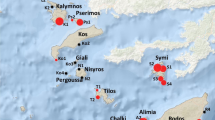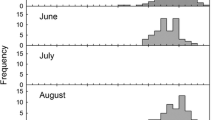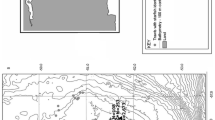Abstract
The European fanworm Sabella spallanzanii (Gmelin, 1791) was recently introduced to Port Phillip Bay and is now a conspicuous component of most benthic communities. Reproduction of the worm was investigated in a population at Queenscliff over a 2 yr period (October 1995 to October 1997) using gonadal histology. The worms are dioecious (sex ratio 1:1, n=250), and attained sexual maturity at ∼50 mm body length. Reproductive periodicity followed a distinct annual cycle, and spawning proceeded through an extended autumn/winter period. Spawning was broadly synchronous between sexes, and coincided with falling seawater temperatures and shorter day-lengths. The females were highly fecund, and >50 000 eggs were probably shed from large females (>300 mm body length) during the annual spawning period. Breeding cycles of S. spallanzanii in Port Phillip Bay are ∼6 mo out of phase with endemic populations located at similar latitudes in the northern hemisphere. The spread of S. spallanzanii within Port Phillip Bay has been monitored by divers on an annual basis since 1994. The most recent dive survey (1998) indicates that S. spallanzanii has extended its range through out the entire 2000 km2 embayment, and has invaded most subtidal habitats. Quantitative estimates of S. spallanzanii abundances were highest on pier pylons (12.5 individuals m−2, 0.5 to 7 m depths). On sediments, estimates were highest at shallow sites (0.3 m−2, 7 m depth), but numbers declined significantly with depth (0.1 m−2, 17 to 22 m depth). Mean worm lengths and biomass were, by contrast, significantly higher at intermediate depths (12 to 17 m) than in shallower (7 m) or deeper (22 m) locations. S. spallanzanii demonstrates a clear preference for growth in sheltered, nutrient-enriched waters, so it may not spread from Port Phillip Bay into the adjacent oceanic waters of Bass Strait; however, in view of S. spallanzanii's current high abundance, fecundity and extended spawning periodicity, there is a high risk of future range expansions, mediated by shipping, into other temperate-water ports.
Similar content being viewed by others
Author information
Authors and Affiliations
Additional information
Received: 17 November 1998 / Accepted: 6 January 2000
Rights and permissions
About this article
Cite this article
Currie, D., McArthur, M. & Cohen, B. Reproduction and distribution of the invasive European fanworm Sabella spallanzanii (Polychaeta: Sabellidae) in Port Phillip Bay, Victoria, Australia. Marine Biology 136, 645–656 (2000). https://doi.org/10.1007/s002270050724
Issue Date:
DOI: https://doi.org/10.1007/s002270050724




